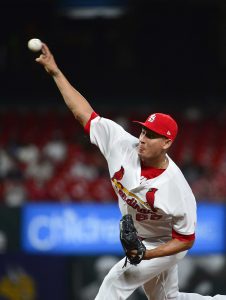Cardinals closer Jordan Hicks will open the 2020 season on the injured list, manager Mike Shildt told reporters Wednesday (Twitter link via Derrick Goold of the St. Louis Post-Dispatch). The flamethrowing 23-year-old underwent Tommy John surgery last June and is still in the final stages of his rehab process.
Back in May, Hicks had progressed to the point where he was able to throw multiple 20-pitch bullpen sessions. About six weeks have elapsed since that time, but it doesn’t seem that Hicks is yet at the point where he can immediately contribute. The club does expect him to factor into the bullpen before too long, though no clear timetable was provided.
Hicks turned in a sharp rookie season back in 2018, tossing 77 2/3 innings of 3.59 ERA ball — albeit with a more troubling 5.2 BB/9 mark and 13.3 percent overall walk rate. He looked to be taking his game to another level in 2019, though. Prior to going on the injured list, Hicks pitched 28 2/3 frames with across-the-board improvements in ERA (3.59 to 3.14), FIP (3.74 to 3.21), K/9 (8.1 to 9.7), K% (20.6 percent to 28.2 percent), BB% (13.3 percent to 10.0 percent) and ground-ball rate (60.7 percent to 67.2 percent). Those results and a fastball that averaged 101.6 mph in his brief career to date certainly paint the picture of a potentially dominant reliever.
With Hicks on the shelf to begin the year, the Cards should have plenty of alternatives — headlined by 2019 breakout setup man Giovanny Gallegos and veteran southpaw Andrew Miller. Gallegos, acquired in the 2018 Luke Voit trade with the Yankees, has helped to balance the scales on what initially looked like an inordinately lopsided deal. But while Voit came roaring out of the gates in the Bronx, Gallegos slowly and steadily increased his role in the St. Louis bullpen and wound up with downright dominant results in 2019: 74 innings, 2.31 ERA, 3.05 FIP, 11.3 K/9, 1.9 BB/9, one save, 19 holds. He’s controlled for another five seasons, so it seems the Cards may have unearthed a key long-term bullpen piece.
As for the 35-year-old Miller, the 2019 season wasn’t his strongest. Like many pitchers, Miller saw his home-run rates skyrocket last year as hitters piled up big flies at record rates amid revelations about alterations to the ball’s composition. Miller’s 4.45 ERA and 5.19 FIP were his highest marks since breaking out as a high-end reliever, but he still averaged 11.5 strikeouts per nine innings pitched.
